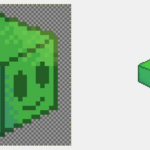As game designers, it is our job to create an engaging experience for the player. A well-established game design not only helps us turn our vision into a memorable game, but also provides an essential framework upon which we can build the game in the first place.
That being said, game design is also a tricky field to navigate – whether you’re a hobbyist or looking to become a game designer as a career. There are a lot of aspects to consider that go beyond what your game is about and game balance. So, where do you start?
Well, in this post adapted from material by Daniel Buckley, we’re going to cover the most fundamental design principles that every game developer should know before making their first game. Hopefully, after reading this post, you should feel much more confident in creating a game that delivers an engaging experience for the player and sets you on the right path to mastering the exciting topic of game design!
Table of contents
CREATING THE IDEA
Let’s begin with a potential game idea, assuming that you’ve just started creating a new game. What is the game going to be in its simplest form? What is the player going to do, and how are they going to do it? The best way to tackle these problems is to keep your ideas as simple as possible, and the most effective way to achieve that is by figuring out the Core Mechanic of the game.
Q: What is Core Mechanic?
A Core Mechanic is the main ‘action of play’, which makes the system that the player does throughout the game.
For example, in a typical 2D platformer game, players can run and jump. A jump can actually mean various other actions, such as:
- Defeating enemies
- Hitting blocks
- Avoiding obstacles
- Ending the level
Did you come across any errors in this tutorial? Please let us know by completing this form and we’ll look into it!

FINAL DAYS: Unlock coding courses in Unity, Godot, Unreal, Python and more.
Q: Why is it important to have a Core Mechanic?
It’s because games with a core mechanic have a flexible scope. We can start simple, and then, later on, add more systems that can utilize this core mechanic, such as adding a double-jump feature, creating more enemies to jump on, creating more destructible blocks, etc.
When starting out a new game, you don’t want to go overboard thinking of all the new things you can implement and then overwhelm yourself eventually. Having a core mechanic in your game means you can focus all of your attention on a single system that you can refine and iterate upon. It can make game development much easier, and expanding from the core mechanic is definitely something you should have in mind.
Remember that Less is more. If you’re inclined to read more about why you should practice minimalism in games, I recommend you reading this article by Gabriel Lievano on Gamasutra.

EXPERIENCE
Games and all other forms of media are there to deliver their audience a certain experience. Solidifying your game experience to deliver is vital to creating the game that you’re envisioning and giving the players the experience that you want. In other words, knowing what experience you want for the player, and making sure that all design choices encourage that experience is important.
Q: What is the specific experience that the player should have?
Whenever you’re adding in a new system or a new level, you need to make sure that whatever you’re adding to your game is encouraging the specific experience.

When choosing which type of experiences to deliver, it’s important to ask yourself: How do you want the player to feel? Do you want the player to be laughing, or scared? There are several different types of experiences you can deliver, such as:
- Challenge
- Thrill
- Comedy
- Exploration
- Horror
- Co-op
- Strategy
- Narrative
- Sensation
- Fantasy
- Expression, etc.
Q: Who is the target audience?
Researching your game’s target audience is also crucial, especially if you’re going to publically launch your game for profit. You’ll need to make a good guess about who your players might be, (i.e. the demographics of the majority of the players) and what their interests might be.
- Age
- Sex
- Location
- Level of Education
- Religion
- Race
- Ethnicity
- Marital Status
- Sexual Orientation
You probably wouldn’t want to create a horror game if your target audience is children in kindergarten. You also probably wouldn’t want to include any contents that may come across as too offensive to the specific target demographic.
Q: How do I encourage a specific experience?
Let’s think about some design decisions you might make to encourage a Horror experience, for example.
- First of all, you might make your levels have a dark environment with little light. This gets immediately scary as you don’t know what is a few meters ahead of you in the darkness.
- You might also want to slow down the player’s movement. If the player is able to move fast, that might make them feel braver in going into a dark room, whereas if they move slowly it will take them a bit more effort in order to escape.
- Ambient and environmental sounds (e.g. amplifying footsteps, the echoes in the walls, subtle sounds to hint at something around the corner.) These can create tension and build more immersion in the game world.
- Occasional silence can also contribute to the horror experience, as it creates a dramatic contrast to tense music.
- Each mechanic, goal, and system in the game should contribute to giving the player the horror experience.

GOALS
Games are an interactive medium, so there should always be things for the players to do and work towards. Such goals can either be short-term or long-term.
Q: Short term vs. Long Term Goals
Short-term goals can be something like climbing a tower, completing a quest, etc. They not only contribute to or complement the long-term goal, but also keep the player engaged. If you just had a long-term goal with no short-term goals in between, the game would be boring since there’s nothing to do in the meantime. By accomplishing short-term goals, you can stay engaged and entertained while working towards the long-term goal.
Long-term goals are often the main conflict of your game. They should complement the game’s experience. For example, if you’re making an action game, your long-term goal may be to defeat the antagonist.
As a quick example, let’s have a look at the goals of Chess.

- The short-term goal of chess is to capture a specific piece.
- The long-term goal is to checkmate your opponent.
- As you accomplish more of the short term goal, they make the long-term goal easier to accomplish.
Q: How will the player know the goals that you want them to complete?
You can guide the player to their goals through various different forms, such as:
- Opening exposition (e.g. Cinematic, NPC dialogue)
- Quests
- Visualizing the goals (e.g. Level design, GUI)
Many open-world games like Skyrim or Half-Life 2 visualize the goals that you’re trying to achieve. This might be a large mountain or a building that is embedded in the level design.


SYSTEMS
When talking about video games, there are two types of labels that you could apply to a game. A game could be linear, or it could be emergent.
Q: Linear Gameplay vs. Emergent Gameplay
Linear gameplay is where the player’s actions are predictable and intended by the developer. Games like Call of Duty and The Last of Us have been specifically designed so that a player goes along a specific route, encounters enemies at a specific time, and generally goes through the game at a relatively similar pace compared to other players.

Emergent gameplay is where a player’s actions aren’t necessarily what the developer intended. And this is where systemic gameplay comes in as well. In games like Minecraft, Breath of the Wild, and many open-world sandbox games feature emergent gameplay, with various different systems that can interact with each other in unique ways.

Q: What is Systemic gameplay?
Systemic games are designed in a way so that individual systems can reach out and interact with one another.
Let’s say we have these two systems in our game:
- Fire System: Can ignite objects and enemies on fire
- Water System: Can extinguish the fire and prevent fires from starting
An emergent gameplay behavior would be for the player to douse themselves in water before a fight with an enemy who uses fire. The Legend of Zelda: Breath of the Wild is a great example that has a lot of different systems that can interact with each other (e.g. fire, ice, electricity, etc.), encouraging emergent gameplay.


Another example is Dwarf Fortress, which has a large number of interacting systems and procedural content. It’s an entirely procedurally generated world, and every player gets an entirely different experience based on the interacting systems that emerge from their gameplay.

Take this Challenge!
Try and think of a game that you’ve played where its systems interacted with one another. For example, in Minecraft, if you shoot an arrow through the fire, that arrow will then become a fire arrow, doing fire damage to the enemies that it hit.
- Think of a game you’ve played.
- Think of a time where two of the game’s systems interacted with one another.
AFTER READING THE POST
So you understand the fundamentals of game design, but where do you go from here? Here are some ideas that will help further boost your game design knowledge with skills you can apply to your games.
Create A High-Level “Game Design Document” of your game.
If you have a game concept or a game idea that you’ve been keeping in mind, or if you’re about to actually start making a game, then I recommend you to take the challenge of creating a Game Design Document. Start writing down an overview of all aspects of the game, including concepts such as rules, mechanics, goals, rewards, audiovisual style, etc. Using a dot-point list and a mind map is also quite helpful.
A high-level document should be general and broad in scope. It should address key theoretical concepts, but not everything needs to be refined and perfected. Try your best to give clear descriptions of the key elements, especially those which make the game stand out from others. Here is an example:
- Overview
- Goals
- Rules & Mechanics
- Player Roles
- Narrative
- Art Style
- Audio (Sound Design)
- Platform & Technical Requirements
- Market Research (Target audience, Competitors, and/or Inspirational games)
Alternatively, you might find filling out existing GDD templates more useful, such as this free one from UNC Computer Science. If you want more information about Game Design Documents, you can also check out our full article on that concept.
ADDITIONAL RESOURCES
Here are a few resources which can help you if you want to learn more about a core game mechanic:
- Intro To Game Design by Daniel Buckley
- How to Guide Players through Games – Game Design Tips by Lindsay Schardon
- What is Game Design: The Creative Side of Development by Lindsay Schardon
- How to Design a Game: Game Design Documents by Tim Bonzon
- How to Approach Narrative Game Design by Cypress Reeves
- The Art of Game Design by Jesse Schell
- Designing Around a Core Mechanic by Gamasutra
Conclusion
As mentioned at the beginning, game design is an entire field of study – and we’ve only scratched the surface of how deep this topic can go. Nevertheless, you’ve gained integral foundations for beginning your journey into it. Hopefully, you’ve not only learned about some key concepts, but also seen how these technical aspects play a role at the creative core of every game.
No matter what type of game you want to create, keep the game design in mind. And, with these concepts as part of your toolkit, you can continue making your games the very best experiences they can be!






